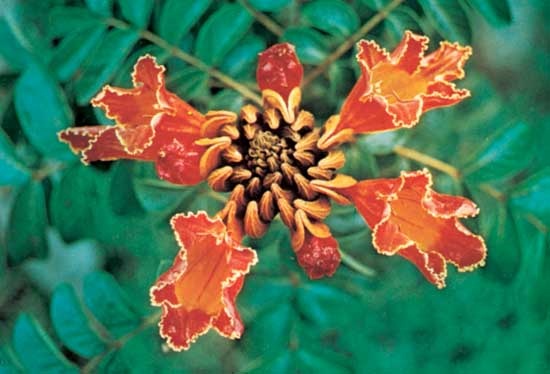Bignoniaceae
plant family
 the trumpet creeper or catalpa family of the mint order of flowering plants (Lamiales). It contains about 112 genera and more than 725 species of trees, shrubs, and, most commonly, vines, chiefly of tropical America, tropical Africa, and the Indo-Malayan region. They form an important part of the tropical forest vegetation because of the numerous climbing vines. A few are found in temperate regions, notably the catalpa tree (Catalpa), the trumpet creeper (Campsis), and the cross vine (Bignonia).
the trumpet creeper or catalpa family of the mint order of flowering plants (Lamiales). It contains about 112 genera and more than 725 species of trees, shrubs, and, most commonly, vines, chiefly of tropical America, tropical Africa, and the Indo-Malayan region. They form an important part of the tropical forest vegetation because of the numerous climbing vines. A few are found in temperate regions, notably the catalpa tree (Catalpa), the trumpet creeper (Campsis), and the cross vine (Bignonia).The family is characterized by oppositely paired, usually compound leaves and bell- or funnel-shaped, bisexual flowers having a five-lobed calyx and corolla; two long and two short stamens arising from the corolla tube; and a pistil positioned above the attachment point of the other flower parts, on a disk, and consisting of two fused, ovule-bearing carpels enclosing two, or rarely one, chambers that contain many ovules attached along the central axis. The seeds are usually flat and winged.
Among the important ornamental and useful members are the African tulip tree (Spathodea), calabash tree (Crescentia cujete), sausage tree (Kigelia pinnata), trumpet creeper (Campsis), cross vine (Bignonia capreolata), cat's claw (Macfadyena unguis-cati), the timber-producing West Indian boxwood (Tabebuia), jacaranda (Jacaranda), empress tree (Paulownia), flowering willow (Chilopsis), and Cape honeysuckle (Tecoma capensis).
- portal vein
- Port Angeles
- Port Antonio
- Port Arthur
- portative organ
- Port Augusta
- Port-au-Prince
- Port Authority of New York and New Jersey
- Port Blair
- Port-Cartier
- Port Colborne
- Port Davey
- port de bras
- Port-de-Paix
- Port Dickson
- porte cochere
- Port Elizabeth
- Porteous Riots
- Porter, Cole
- Porter, David
- Porter, David Dixon
- Porter, Edwin S.
- Porter, Eleanor Hodgman
- Porter, Eliot
- Porter, Eliza Emily Chappell